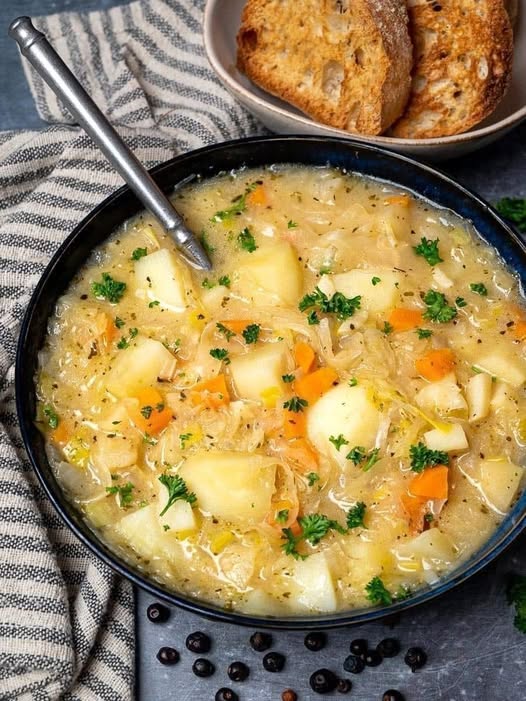ADVERTISEMENT
For Complete Cooking STEPS Please Head On Over To Next Page Or Open button (>) and don’t forget to SHARE with your Facebook friends
### **Why You’ll Love Polish Sauerkraut Soup (Kapusniak)**
– **Rich, Bold Flavors**: The tanginess of the sauerkraut, combined with the savory depth of the pork and the sweetness of the vegetables, creates a rich, well-balanced soup that’s full of flavor.
– **Nourishing and Hearty**: With the addition of pork and vegetables, this soup is satisfying and filling—perfect for a cozy meal.
– **A Taste of Tradition**: By making Kapusniak, you’re embracing a centuries-old Polish tradition that has been passed down through generations.
– **Versatile**: Whether you prefer it with pork or want to make a vegetarian version, Kapusniak can easily be adapted to suit dietary preferences.
### **Ingredients You’ll Need**
To make this traditional Polish soup, you’ll need the following ingredients:
**For the Soup:**
– **1 lb (450g) pork (pork shoulder, ribs, or bacon)** – cut into pieces (you can also use sausage for added flavor)
– **1 onion**, chopped
– **2 medium carrots**, peeled and sliced
– **2 medium potatoes**, peeled and diced
– **4 cups sauerkraut** (drained and rinsed to remove excess salt, if preferred)
– **1-2 bay leaves**
– **2 teaspoons dried marjoram** (a key herb in Polish cuisine)
– **4 cups of chicken or vegetable broth** (you can also use water if you prefer)
– **Salt and pepper**, to taste
– **2 tablespoons vegetable oil** (for sautéing)
– **1 tablespoon vinegar** (optional, to balance the flavor of the sauerkraut)
– **1 tablespoon sugar** (optional, to mellow out the acidity)
– **Fresh dill** (for garnish, optional)
**Optional Ingredients for Extra Flavor:**
– **Smoked bacon** or **sausage** for a deeper smoky flavor
– **Garlic**, minced (for extra aroma)
– **Sour cream** (to add creaminess and richness when serving)
– **Sliced kielbasa sausage** (for additional texture and flavor)
### **Step-by-Step Instructions**
#### **1. Prepare the Meat**
If you’re using **pork shoulder** or **pork ribs**, start by cutting the meat into chunks. In a large pot or Dutch oven, heat **2 tablespoons of vegetable oil** over medium-high heat. Brown the pork pieces on all sides, which will help to develop a rich, savory flavor. Once the pork is browned, remove it from the pot and set it aside.
#### **2. Sauté the Vegetables**
In the same pot, add **chopped onion** and sauté it until it becomes translucent, about **3-4 minutes**. Add the **carrots** and sauté for another **3-4 minutes**. This step brings out the natural sweetness of the vegetables, which balances the tanginess of the sauerkraut.
#### **3. Add the Sauerkraut**
Add the **sauerkraut** to the pot with the onions and carrots. If you prefer a milder tang, you can rinse the sauerkraut under cold water to remove some of its saltiness before adding it to the soup. Stir the sauerkraut into the vegetables, allowing it to absorb the flavors for a few minutes.
#### **4. Add the Broth and Seasonings**
Return the browned pork to the pot, along with the **bay leaves**, **dried marjoram**, and the **broth** (or water). Bring the soup to a boil, then reduce the heat and simmer for about **1 hour**. This slow cooking process helps the flavors meld together and tenderizes the pork.
#### **5. Add the Potatoes**
After an hour, add the **diced potatoes** to the soup. Continue to cook for another **30-40 minutes**, until the potatoes are tender and the pork is fully cooked. You may need to add additional broth or water during cooking to maintain the desired consistency.
#### **6. Final Adjustments**
Taste the soup and adjust the seasonings as needed. You can add **salt**, **pepper**, and a bit of **vinegar** or **sugar** to balance the acidity of the sauerkraut and bring out the flavors. If you prefer a smoother soup, you can use an immersion blender to purée some of the vegetables.
#### **7. Serve**
Once the soup is ready, ladle it into bowls and garnish with **fresh dill**. For added richness, you can serve it with a dollop of **sour cream** on top. **Crusty bread** or **rye bread** pairs wonderfully with this soup for a truly comforting meal.
### **Tips for the Perfect Kapusniak**
1. **Use High-Quality Sauerkraut**: The sauerkraut is the star of this dish, so use a high-quality, well-fermented sauerkraut for the best flavor. If you have access to homemade sauerkraut, that’s even better!
2. **Smoked Meat**: For extra depth of flavor, consider adding **smoked bacon** or **smoked sausage** to the soup. The smoky undertones enhance the richness of the broth and complement the tangy sauerkraut.
3. **Adjust the Acidity**: Sauerkraut can be quite tangy, so be sure to taste the soup and adjust the acidity to your liking. A bit of **vinegar** or **sugar** can help balance the flavor.
4. **Slow Cooking**: The longer you simmer Kapusniak, the more the flavors will develop. Aim for a slow simmer to ensure the pork becomes tender and all the ingredients are well integrated.
5. **Serve with Rye Bread**: Kapusniak is traditionally served with thick slices of rye bread or **Polish sourdough**. The bread is perfect for soaking up the flavorful broth.
### **Conclusion: A Comforting Taste of Poland**
Polish **Sauerkraut Soup (Kapusniak)** is a comforting, flavorful dish that’s packed with tradition and rich in taste. The tangy sauerkraut, tender pork, and hearty vegetables come together in perfect harmony, creating a soup that’s both satisfying and soul-warming.
Whether you’re preparing it for a cozy meal at home or sharing it with friends and family, Kapusniak is a dish that brings people together and celebrates Polish culinary heritage. With its bold flavors and nourishing ingredients, this classic soup is sure to become a favorite in your kitchen.
